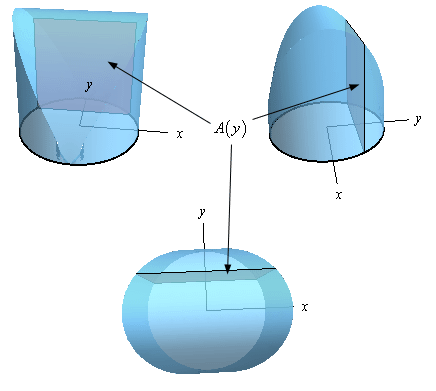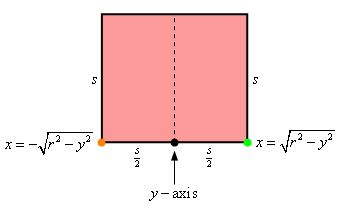Section 6.5 : More Volume Problems
2. Find the volume of the solid whose base is a disk of radius \(r\) and whose cross-sections are squares. See figure below to see a sketch of the cross-sections.

Show All Steps Hide All Steps
Here are a couple of sketches of the solid from three different angles. For reference the positive \(x\)-axis and positive \(y\)-axis are shown.

Because the cross-section is perpendicular to the \(y\)-axis as we move the cross-section along the \(y\)-axis we’ll change its area and so the cross-sectional area will be a function of \(y\), i.e. \(A\left( y \right)\).
While the sketches above are nice to get a feel for what the solid looks like, what we really need is just a sketch of the cross-section. So, here’s a couple of sketches of the cross-sectional area.

The sketch on the left is really just the graph given in the problem statement with the only difference that we colored the right/left sides so it will match with the sketch on the right. The sketch on the right looks at the cross-section from directly above and is shown by the red line.
Let’s get a quick sketch of just the cross-section and let’s call the length of the side of each square \(s\).

Now, along the bottom we’ve denoted the \(y\)-axis location in the cross-section with a black dot and the orange and green dots represent where the left and right portions of the circle are at. We can also see that, assuming the cross-section is placed at some \(y\), the green dot must be a distance of \(\sqrt {{r^2} - {y^2}} \) from the \(y\)-axis. Likewise, the orange dot must also be a distance of \(\sqrt {{r^2} - {y^2}} \) from the \(y\)-axis (recall we want the distance to be positive here and so we drop the minus sign from the function to get a positive distance).
Now, we know that the area of the square is simply \({s^2}\) and from the discussion above we see that,
\[\frac{s}{2} = \sqrt {{r^2} - {y^2}} \hspace{0.5in} \Rightarrow \hspace{0.5in}s = 2\sqrt {{r^2} - {y^2}} \]So, a formula for the area of the cross-section in terms of \(y\) is,
\[A\left( y \right) = {s^2} = {\left( {2\sqrt {{r^2} - {y^2}} } \right)^2} = 4\left( {{r^2} - {y^2}} \right)\]Finally, we need the volume itself. We know that the volume is found by evaluating the following integral.
\[V = \int_{c}^{d}{{A\left( y \right)\,dy}}\]We already have a formula for \(A\left( y \right)\) from Step 2 and from the sketches in Step 1 we can see that the “first” cross-section will occur at \(y = - r\) and that the “last” cross-section will occur at \(y = r\) and so these are the limits for the integral.
The volume is then,
\[V = \int_{{ - r}}^{r}{{4\left( {{r^2} - {y^2}} \right)\,dy}} = \left. {4\left( {y{r^2} - \frac{1}{3}{y^3}} \right)} \right|_{ - r}^r = \require{bbox} \bbox[2pt,border:1px solid black]{{\frac{{16}}{3}{r^3}}}\]Do not get excited about the \(r\) integral and area formula. It is just a constant. The only letter that is actually changing is \(y\).